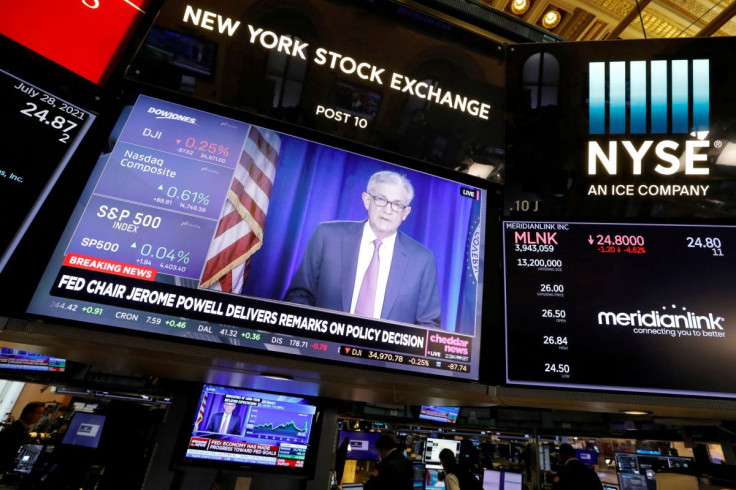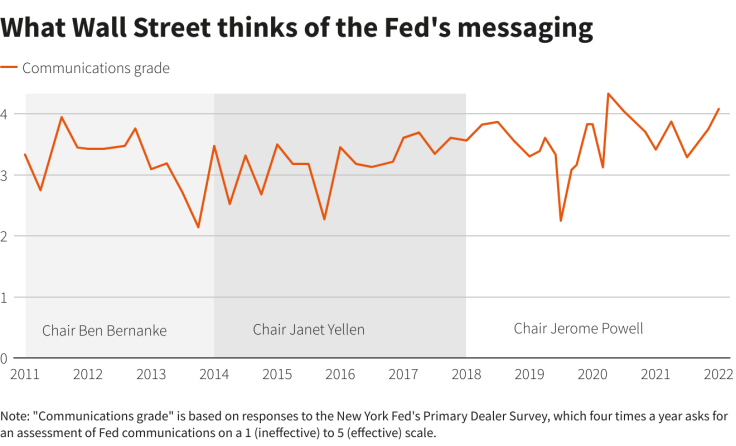Fed Chair Powell Is Not Done Telling Markets Where Rates Will Go

Since it began its current round of interest-rate hikes this year, the U.S. Federal Reserve has aimed to let investors know ahead of time not just where rates are heading generally but exactly how big a move to expect each time.
And despite some snags, including what analysts say was a last-minute but successfully telegraphed change of plans before the June meeting, Fed Chair Jerome Powell isn't likely to abandon those efforts.
The Fed and other central banks have long used that signaling - known as forward guidance in their parlance - to set expectations about where policy is headed to help create the financial conditions conducive to their goal. Coming out of the 2007-2009 financial crisis, for instance, the Fed set very long-term guidance that ensured rates would not rise for years.
The past year's run-in with the highest inflation in a generation has forced changes to that - in particular, shortening the horizon over which they can pledge certain actions.
"It's a very difficult environment to try to give forward guidance 60, 90 days in advance," Powell said at a press conference after May's meeting. "There are just so many things that can happen in the economy and around the world. So, you know, we're leaving ourselves room to look at the data and make a decision as we get there."
Indeed, other central banks are encountering similar challenges and are responding in new ways. The European Central Bank last week raised rates more than it had promised at its prior meeting and did not provide guidance for the size of next month's increase. The Bank of Canada delivered a surprise full percentage point interest-rate increase earlier this month without breathing a word in advance.
But as the head of the world's most important central bank now undertaking its sharpest bout of policy tightening in decades, Powell has a particular stake in making sure markets don't under- or over-estimate what is coming, analysts say.
On Tuesday, U.S. central bankers start a two-day meeting at which they are expected to ratify a 0.75 percentage point increase, the bigger of two possible increments that Powell weeks ago said would be under consideration.
And despite uncertainty over what data on inflation and employment in the next two months will show, analysts broadly expect Powell to put some parameters around September's rate hike decision as well.
"Monetary policy works through market expectations, and if they go haywire, you end up tightening more than you want," said Piper Sandler economist Roberto Perli. "I think it's a tough game to play, but I think it's reasonable for them to play."
Former Fed governor and now Fed-watcher Larry Meyers says that on Wednesday Powell may avoid a specific promise on the size of the next hike, but may take "any opportunity to leave the impression it will be 50 or 75" basis points and "not to give the markets an incentive to build in 100."
He'll also be looking for Powell to lay the groundwork for an eventual pause in rate hikes by discussing what inflation "thresholds" could trigger a slower pace of tightening.
SHOCKED THE MARKETS
The Fed began increasing its policy rate in March, lifting it a quarter of a percentage point and noting that "ongoing increases in the target range will be appropriate," a phrase most analysts expect it will repeat this week.
Powell had indicated the size of the March move a couple weeks ahead of time, and likewise signaled, and then delivered, a half-point hike in May.
The pattern changed in June, when the Fed delivered a 75-basis-point hike, despite having for weeks signaled a smaller hike.
But even then, markets were prepped for it, thanks to a Wall Street Journal article less than 48 hours ahead of the decision that flagged the possibility of a bigger increase, given data days earlier showing inflation and inflation expectations rising faster than anticipated.
The story was widely interpreted as a message from the Fed, which has generally gotten high marks under Powell for its communications effectiveness.
GRAPHIC: What Wall Street thinks of the Fed's messaging (

)
To Karim Basta, chief economist at III Capital Management, the last minute switch was "suboptimal" and could have been avoided if Powell hadn't given such specific guidance in the first place.
"It shocked the markets, it certainly shocked me, and again it's really unnecessary," he said, adding he would prefer for Powell to stick to giving a range of rate hike possibilities - or not say anything at all.
This week's rate hike will lift the Fed's policy rate to what policymakers say is a "neutral" level, and further increases in borrowing costs are expected to bite into economic growth and eventually inflation as well.
SGH Macro Advisors' Tim Duy is among economists who say the central bank's delay in reacting to rising inflation last year forced policymakers this year to push rates up far more quickly than otherwise.
"They fell so far behind the data it became impossible for them to follow through with the communications the way they typically would or they would like to," Duy said. And it may not get easier, especially when they decide it is time to slow rate hikes to a more usual quarter-point increment.
Markets may react by immediately pricing in rate cuts, Duy said, easing financial conditions and nudging up demand before the Fed may feel inflation is heading convincingly down.
"The idea they will pivot to a measured pace of rate hikes is going to be confused with a pivot toward cutting - that's the communications challenge," Duy said.
© Copyright Thomson Reuters {{Year}}. All rights reserved.




















